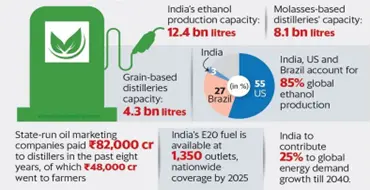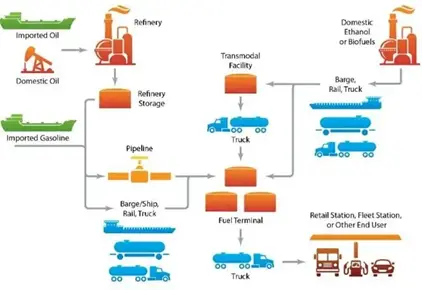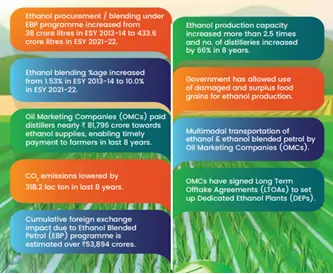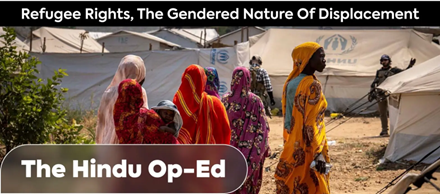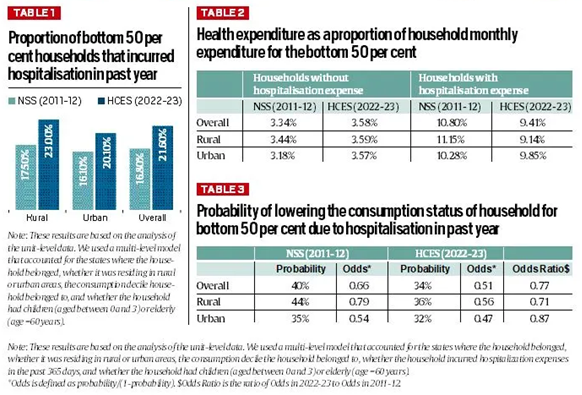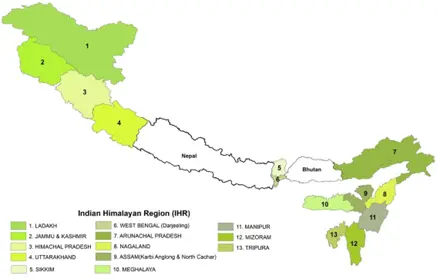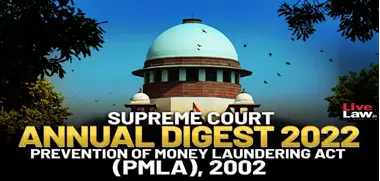Tuesday, 13th August 2024
Parties, Serious Crimes, and the Need for Judicial Clarity
Why in the news?
- The Supreme Court's recent observations in bail petitions involving Delhi's CM and former Deputy CM have raised important issues about the involvement of political parties in cases under the Prevention of Money Laundering Act (PMLA).
- The distinction between policymaking and criminality. These need careful legal analysis due to their potential impact on India's political and judicial landscape.
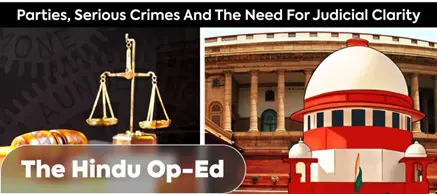
About the Prevention of Money Laundering Act, 2002 (PMLA):
- The Prevention of Money Laundering Act (PMLA), enacted in 2002, is a key legislation in India targeting money laundering and financial crimes.
- Objectives:
- Prevent Money Laundering: The PMLA aims to prevent the process of money laundering, which involves disguising the origins of illegally obtained money.
- Confiscation and Investigation: It provides for the confiscation of properties involved in money laundering and establishes mechanisms for detecting and investigating such offences.
Implication of Political Parties Under PMLA:
- Can a Political Party be Implicated Under PMLA?
- The SC's observations sparked debate on whether political parties can be held liable under the PMLA, especially under Section 70, which applies to companies and associations involved in economic activities.
- Section 70 of the PMLA:
- It targets companies and other associations involved in economic activities.
- The question arises whether political parties, which are ideological organisations rather than business entities, fall under this definition.
- ED’s Argument to Implicate AAP Under PMLA:
- The ED argued that political parties could be seen as associations of individuals under Section 70, referencing the Representation of the People Act (RPA).
- Distinction from Business Entities: Political parties operate within election laws, not economic transaction laws, and are not typically engaged in activities targeted by the PMLA.
The Debate on Policymaking vs. Criminality:
- Policymaking vs. Criminality:
- The SC questioned the line between policymaking and criminality, especially concerning cabinet-approved policies.
- Role of the Cabinet: The cabinet holds exclusive authority in policy matters, and the judiciary traditionally refrains from evaluating cabinet decisions unless they are unconstitutional.
- The Supreme Court’s Role:
- The SC has upheld that policy decisions are beyond judicial scrutiny unless they violate fundamental rights.
- Charging Ministers with criminality for cabinet-approved policies could undermine governance.
Way Forward: The Need for Judicial Clarification:
- Clarification Required: The SC's observations raise critical legal questions. Extending the PMLA to political parties could destabilise the political system, and blurring policy-making with criminality could harm cabinet functioning.
- Judicial Intervention: Clarifying the law is essential to prevent unfair targeting of political parties under the PMLA and wrongful criminal charges against Ministers for collective decisions.
Conclusion:
The SC's observations in these cases represent significant legal developments. The application of Section 70 of the PMLA to political parties raises complex questions about their role and criminal liability. Judicial clarification is crucial for maintaining the integrity of India's democratic processes and ensuring effective government functioning
|
UPSC Civil Services Examination PYQ Mains Q:1 Money laundering poses a serious security threat to a country’s economic sovereignty. What is its significance for India and what steps are required to be taken to control this menace? (2013) Q:2 Discuss how emerging technologies and globalisation contribute to money laundering. Elaborate measures to tackle the problem of money laundering both at national and international levels. (2021) |
Source: TH
Japan Issues its First-Ever 'Megaquake Warning
Why in the news?
- A recent earthquake with a magnitude of 7.1 on the Richter scale struck southern Japan, prompting Japan's meteorological agency to issue a significant warning regarding the heightened risk of an unprecedented "mega earthquake."
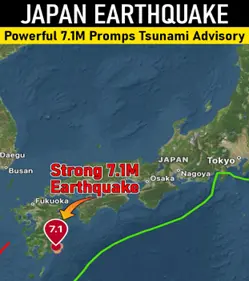
What Concerns are Japanese Authorities Currently Facing?
- Japan's Location on the Ring of Fire:
- Japan experiences approximately 1,500 earthquakes annually, with most causing minimal damage.
- However, Japan has faced devastating exceptions, such as the 2011 magnitude 9.0 earthquake, which triggered a tsunami and nuclear disaster, resulting in over 18,000 deaths along the northeast coast.
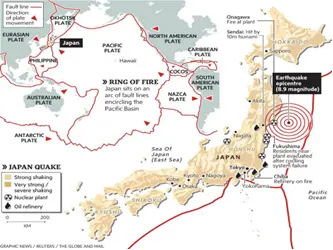
- The Nankai Trough:
- The Nankai Trough is a significant geological feature located off Japan's southwest Pacific coast, extending approximately 800-900 km.
- This trough is formed by the subduction of the Philippine Sea Plate beneath the Eurasian Plate, leading to the accumulation of immense tectonic strains.
- These built-up strains have the potential to trigger a devastating megaquake approximately once every 100 to 150 years.
- For instance, a rupture along the entire 600 km length of the Nankai Trough triggered Japan's second-largest recorded earthquake in 1707, followed by the eruption of Mount Fuji.
- Experts estimate a 70% to 80% probability of a magnitude 8 or 9 earthquake occurring along the Nankai Trough within the next three decades.
Why was the Alert Issued if Earthquakes Can't be Predicted?
- Experts state that the issuance of the warning is not rooted in scientific prediction, as earthquakes are known to be a "clustered phenomenon."
- It is impossible to determine in advance whether a quake is a foreshock or an aftershock.
- Despite this, the alert was issued to encourage preparedness for potential evacuation.
- In several towns, authorities are urging elderly residents and others to voluntarily relocate to safer areas.
What is the Ring of Fire?
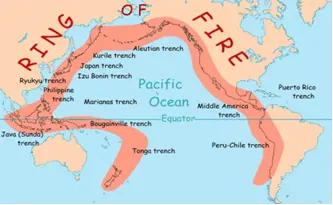
- The Ring of Fire is a tectonic belt of volcanoes and earthquakes, approximately 40,000 km long and up to 500 km wide.
- It surrounds most of the Pacific Ocean and is also known as the Circum-Pacific Belt.
- The Ring of Fire contains between 750 and 915 active or dormant volcanoes, accounting for around two-thirds of the world's total.
- About 90% of the world's earthquakes, including most of the largest, occur within this belt.
Source: IE
India at Paris Olympics 2024
Why in the news?
- India's performance at the Paris Olympics 2024 has drawn attention due to its decline to 71st place in the medal tally from 48th in Tokyo 2020.
- Despite winning six medals—one silver and five bronze—the country faced several near misses and disappointing results, leading to discussions about the future of Indian sports.
Highlights of India’s Performance at Paris Olympics 2024:
- Indian Medal Winners:
|
Athlete |
Medal |
Event |
|
Manu Bhaker |
Bronze |
Women’s 10m Air Pistol |
|
Manu Bhaker & Sarabjot Singh |
Bronze |
10m Air Pistol Mixed Team |
|
Swapnil Kusale |
Bronze |
Men’s 50m Rifle 3 Positions |
|
Indian Hockey Team |
Bronze |
Men’s Hockey |
|
Neeraj Chopra |
Silver |
Men’s Javelin Throw |
|
Aman Sehrawat |
Bronze |
Wrestling Men’s 57kg Freestyle |
- Notable Achievements:
- Neeraj Chopra: Secured a silver medal in javelin with a throw of 89.45 meters. This achievement made him India's fifth two-time Olympic medallist, following his gold medal win in Tokyo 2020.
- Manu Bhaker: Made history as the first Indian woman to win an Olympic shooting medal. She also became the first athlete from independent India to secure two medals in a single Games by winning both in the individual and mixed team events.
- Swapnil Kusale: Achieved India’s first-ever Olympic medal in the 50m Rifle 3 Positions event, marking the highest tally for India in shooting at the Olympics.
- Lakshya Sen: Became the first Indian to reach the semi-finals in men’s badminton, finishing fourth.
- Vinesh Phogat: Reached the final in the women’s 50 kg category but was disqualified for being overweight by 100 grams.
Historical Context:
- India has won a total of 41 Olympic medals. Notable milestones include Norman Pritchard's Silver Medals (1900 Paris), KD Jadhav's Bronze (1952 Helsinki), Karnam Malleswari's Bronze (2000 Sydney), Abhinav Bindra's Gold (2008 Beijing), and Neeraj Chopra's Gold (2020 Tokyo).
- India’s best Olympic performance was at Tokyo 2020 with seven medals, including one gold. The second-best performance was in London 2012, with six medals (two silver and four bronze).
Reasons for India’s Struggles in Securing Olympic Medals
- Talent Identification:
- Talent identification in India often occurs on an ad-hoc basis with limited effectiveness, especially in remote and underserved areas.
- The system lacks a comprehensive approach to scouting and nurturing young athletes, which results in missed opportunities for identifying and developing potential talent.
- Infrastructure and Resources:
- Limited access to training facilities, coaching expertise, and financial support hinders the development of athletes.
- For instance, prominent Winter Olympian Shiva Keshavan had to resort to crowdfunding to finance his training and participation.
- Cricket’s Dominance:
- Cricket's overwhelming popularity absorbs a disproportionate amount of sports capital, with 87% allocated to cricket and only 13% for other sports.
- This imbalance affects the development of Olympic sports, as limited resources are available for non-cricket disciplines.
- Insufficient Sports Policies:
- Although recent initiatives like the Target Olympic Podium Scheme (TOPS) aim to improve athlete support, these programs are relatively new and have not yet produced significant results.
- Corruption and Politics in Sports Administration:
- The politicisation and corruption within sports administration impede effective governance and athlete development.
- Bureaucratic hurdles and lack of professionalism in sports organisations often result in the interests of athletes being neglected.
- Absence of a Sports Culture:
- Many families prioritise fields such as medicine or engineering, viewing sports as a less viable career option.
- Additionally, India's complex social structure, including caste and regional identities, further hinders the development of a unified sports culture.
Recommendations for Improving Olympic Performance:
- Grassroots Development:
- This includes identifying and nurturing talent from a young age across various sports disciplines to build a strong foundation for future athletes.
- Investment in Infrastructure:
- Develop world-class training facilities and provide comprehensive support systems for athletes, including psychological support, nutrition, and injury management.
- Small nations like Jamaica and Grenada demonstrate that targeted investment in specific sports can lead to outstanding Olympic success.
- Empowering Athletes:
- Involve athletes in decision-making processes within sports organisations to enhance accountability and transparency.
- Their direct input can lead to better management and support structures.
- Collegiate Sports System:
- Develop a collegiate sports system similar to the NCAA in the United States.
- The NCAA's success in producing Olympic champions highlights the importance of balancing academics and athletics.
- India should offer scholarships and academic support to talented athletes to keep them engaged in sports while pursuing their education.
- Cultural Shift:
- Integrate sports into the education system and promote sports careers within families to foster a more supportive environment for athletes.
- Increased Government Support:
- This includes direct financial support to athletes and investments in coaching and international exposure.
- Aim to increase athlete participation for future Olympics to enhance medal prospects.
Initiatives Related to Sports Development in India:
- Khelo India: Enhance sports infrastructure and increase grassroots participation.
- National Sports Development Fund (NSDF): Support sports development through financial contributions.
- Sports Authority of India (SAI): 1984, SAI manages various schemes for promoting sports, including the National Sports Academy (NSA) Scheme, Center of Excellence Scheme, National Sports Talent Contest Scheme (NSTC), Army Boys Sports Company Scheme, Special Area Games Scheme, and the COME and PLAY Scheme.
- National Sports Awards: Includes Rajiv Gandhi Khel Ratna, Arjuna Awards, Dhyan Chand Awards, and Dronacharya Awards to celebrate sporting excellence and inspire future athletes.
- Scheme for Sports & Games for People with Disabilities: 2009-10, provides specialised training and support to athletes with disabilities to enhance their participation and skills.
- Rajiv Gandhi Khel Abhiyan: 2014, aims to build sports complexes at the block level to improve local sports infrastructure.
- Fit India Movement: Promote physical fitness and encourage participation in sports nationwide.
|
UPSC Civil Services Examination, Previous Year Question (PYQ) Prelims Q:1 Consider the following statements in respect of the Laureus World Sports Award which was instituted in the year 2000: (2021)
Which of the above statements are correct?
Ans: (c) |
Antarctica's Deep Winter Heatwaves
Why in the news?
- Recently, Antarctica has been experiencing a significant deep-winter heatwave, marking the second instance of record-breaking temperatures in two years.
- Since mid-July 2024, ground temperatures have risen by an average of 10 degrees Celsius above normal, with some areas seeing increases of up to 28 degrees Celsius.
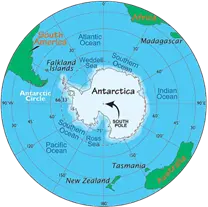
Causes of Deep-Winter Heat Waves in Antarctica:
- Weakening of the Polar Vortex:
- Description: The polar vortex is a large area of low pressure and cold air surrounding the poles. It helps keep colder air near the poles but weakens in summer and strengthens in winter.
- Impact: Higher temperatures and powerful atmospheric waves have disrupted the polar vortex, allowing warm air from above to descend into Antarctica, leading to a rise in temperatures.
- Reduction of Antarctic Sea Ice:
- Description: Antarctic sea ice has reached historically low levels, diminishing its ability to reflect solar energy and act as a barrier between cold air and warmer waters.
- Impact: This loss contributes to rising global temperatures by increasing heat absorption and reducing the effectiveness of the ice in insulating colder regions.
- High Rate of Global Warming:
- Description: Antarctica is warming at a rate nearly double that of the global average (0.22 to 0.32 degrees Celsius per decade) compared to Earth's overall rate of 0.14-0.18 degrees Celsius per decade.
- Impact: Accelerated warming in Antarctica is driven by anthropogenic climate change, exacerbating natural climate variability and enhancing the effects of warming.
- Impact of the Southern Ocean:
- Description: The warming Southern Ocean absorbs more heat due to reduced sea ice, creating a feedback loop that further raises air temperatures over Antarctica.
- Impact: This feedback loop increases the risk of extreme weather events and amplifies the warming effect on the continent.
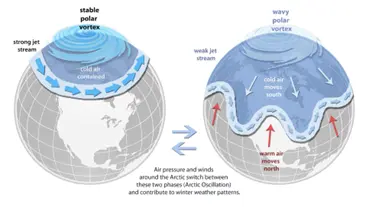
Consequences of Heat Waves in Antarctica:
- Accelerated Ice Melt:
- Description: Rising winter temperatures are speeding up ice mass loss in Antarctica, with a 280% increase in ice mass loss compared to the 1980s and 1990s.
- Impact: Significant ice loss contributes to rising global sea levels. For example, a 2022 heatwave led to the collapse of an ice section of around 1300 square kilometers.
- Global Sea Level Rise:
- Description: The Antarctic Ice Sheet covers 98% of Antarctica and contains over 60% of the world's freshwater.
- Impact: Even a slight rise in sea levels could displace around 230 million people living within 3 feet of existing high tide lines, threatening coastal cities and ecosystems.
- Disruption of Ocean Circulation:
- Description: Freshwater influx from melting ice alters ocean salinity and density, slowing global ocean circulation.
- Impact: This slowdown affects the ocean’s capacity to store and transport heat, carbon, and nutrients, intensifying global warming and increasing extreme weather events.
- Ecosystem Disruption:
- Description: Temperature changes and ice loss disrupt local ecosystems, threatening species dependent on stable ice.
- Impact: Species like polar bears and penguins face survival challenges, leading to biodiversity loss and altered global food webs.
- Feedback Loops:
- Description: Melting ice reduces the albedo effect, which is the ability of surfaces to reflect sunlight. This results in increased heat absorption by oceans and land.
- Impact: The feedback loop accelerates further ice melt and exacerbates climate change.
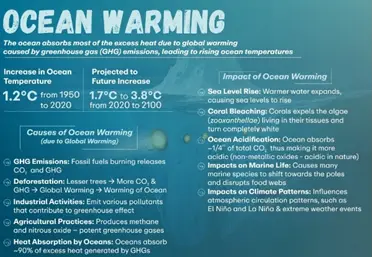
India’s Initiatives for Antarctica:
- Antarctic Treaty:
- An international agreement that establishes Antarctica as a zone of international cooperation for scientific research and environmental protection.
- National Centre for Polar and Ocean Research (NCPOR):
- An Indian research institution that coordinates scientific research in the polar regions and the Southern Ocean.
- Indian Antarctic Act of 2022:
- Legislation that provides a legal framework for India’s activities in Antarctica, ensuring compliance with the Antarctic Treaty and promoting scientific research and environmental protection.
|
UPSC Civil Services Examination, Previous Year Question (PYQ) : Mains Q:1 With reference to the water on the planet Earth, consider the following statements:(2021)
Which of the statements given above is/are correct?
Ans: (b) |
Indian Ocean structures
Why in the news?
- Recently, three underwater geographical structures in the Indian Ocean have been named by the International Hydrographic Organization (IHO) and UNESCO’s Intergovernmental Oceanographic Commission (IOC) based on proposals originally submitted by India.
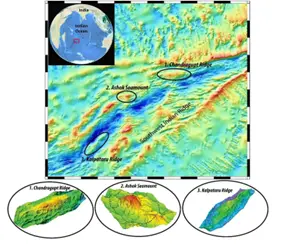
About UNESCO’s Intergovernmental Oceanographic Commission:
- Promotion of Marine Sciences: The IOC promotes international cooperation in marine sciences to enhance the management of oceans, coasts, and marine resources.
- Membership: The IOC comprises 150 Member States, with India being a member since 1946.
- Coordination of Programmes: It coordinates various programmes, including capacity development, ocean observations and services, ocean science, tsunami warning systems, and ocean literacy.
- Ocean Decade Leadership: The IOC is responsible for coordinating the United Nations Decade of Ocean Science for Sustainable Development (2021-2030), also known as the “Ocean Decade.”
Key Facts about Underwater Structures:
- Naming of Structures: There are now seven underwater structures in the Indian Ocean named predominantly after Indian scientists or based on names proposed by India.
- Recent Discoveries: The three recently named structures were discovered by oceanographers from the National Centre for Polar and Ocean Research (NCPOR), Goa.
- Location and Discovery: These structures are located along the Southwest Indian Ridge in the Indian Ocean and were discovered during an international survey exploration programme.
- Indian Southern Ocean Research Programme: India has been conducting the Indian Southern Ocean Research Programme since 2004, with NCPOR as the nodal agency.
Previously Named Structures:
- Raman Ridge (1992): Discovered in 1951 by a U.S. oil vessel, it was named after Physicist and Nobel Laureate Sir C.V. Raman.
- Panikkar Seamount (1993): Discovered by the Indian research vessel Sagar Kanya, it is named after renowned oceanographer N.K. Panikkar.
- Sagar Kanya Ridge (1991): A seamount named after the research vessel Sagar Kanya.
- D.N. Wadia Guyot: Named after geologist D.N. Wadia, this underwater volcanic mountain, known as a guyot, was discovered in 1992 by Sagar Kanya.
Recent Naming:
- Ashoka Seamount and Chandragupta Ridge: These two structures were recently named after rulers of the Mauryan dynasty.
- Kalpataru Ridge: Another structure was named Kalpataru Ridge in the Indian Ocean
Source: IE
Section 27 of the Indian Evidence Act
Why in the news?
- The Supreme Court has recently ruled that a disclosure made by an accused under Section 27 of the Indian Evidence Act is irrelevant if the fact was previously known to the police.

About Section 27 of the Indian Evidence Act:
- Exception to Admissibility of Confession: Section 27 creates an exception to the general rule that confessions made by an accused to a police officer while in custody are inadmissible.
- Protection Against Self-Incrimination:
- Sections 25 and 26 of the Indian Evidence Act establish protections against self-incrimination and prevent the abuse of power by police authorities.
- Confessions made in police custody without the presence of a magistrate are generally inadmissible in court.
- Section 27's Exception:
- However, Section 27 provides an exception, allowing for the admission of confessions that lead to the discovery of facts. This section states:
- "Provided that, when any fact is deposed to as discovered in consequence of information received from a person accused of any offence, in the custody of a police officer, so much of such information, whether it amounts to a confession or not, as relates distinctly to the fact thereby discovered, may be proved."
- Admissibility of Confession: In simpler terms, any confession made by an accused while in police custody that results in the discovery of a fact is considered admissible in court. The confession must:
- Provide information that was previously unknown to the police.
- Lead to the recovery of evidence or identification of witnesses.
- Be directly related to the fact discovered, meaning the information must be specific and relevant.
- Be made voluntarily, without coercion or threats.
- Doctrine of Confirmation by Subsequent Events:
- The fundamental idea underlying Section 27 is the doctrine of confirmation by subsequent events.
- This principle asserts that every part of the statement made by the accused in police custody should be confirmed by the subsequent discovery of facts to be admissible in court.
- Scope of "Fact": In the case of Asar Mohd. v. State of U.P., the Supreme Court held that the term "fact" in Section 27 is not limited to physical objects but also includes essential psychological or mental facts directly relevant to the case.
- Requirement of Corroboration: A confession under Section 27 cannot be used to prove the guilt of the accused unless corroborated by other evidence.
Source: LIVE
Omkareshwar Floating Solar Project
Why in the news?
- Madhya Pradesh has recently commissioned the largest floating solar project in central and north India, with a generation capacity of 90 MW at Omkareshwar.
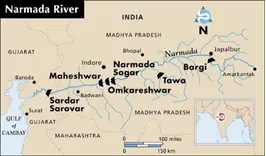
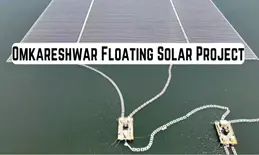
About Omkareshwar Floating Solar Project:
- Location: The project is situated at Omkareshwar in Khandwa District, Madhya Pradesh.
- Floating Power Plant: Developed on the backwaters of the Omkareshwar Dam, a gravity dam on the Narmada River, this floating solar project is the largest of its kind in central and north India.
- Significance: It is the biggest solar park in India and generates 90 MW of energy.
- Development and Execution: The project was developed under the Union Ministry of Renewable Energy and executed by SJVN Green Energy Limited (SGEL), a wholly owned subsidiary of SJVN—a joint venture between the Government of India and the Government of Himachal Pradesh.
- Project Cost: The total cost of the project is ₹646 crores.
- Energy Generation: The project is expected to generate 196.5 million units of electricity in its initial year of operation and a cumulative 4,629.3 million units over 25 years.
- Environmental Impact: Upon commissioning, the project will reduce carbon emissions by 2.3 lakh tons and contribute significantly to India's mission of achieving net-zero carbon emissions by 2070.
- Water Conservation: The floating solar panels will also aid in water conservation by reducing water evaporation from the reservoir.
- Operational Terms: The project was developed through competitive tariff bidding on a Build Own and Operate (BOO) basis for 25 years at a rate of ₹3.26 per unit.
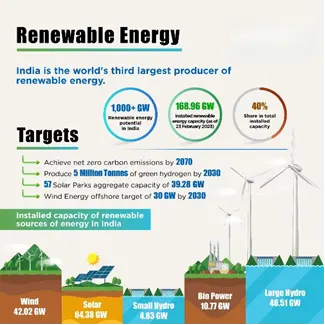
Tantalum
Why in the news?
- Recently, the Central Government included Tantalum in a list of 24 minerals notified as Critical and Strategic in Part D of the First Schedule of the Mines and Minerals (Development and Regulation) Act, 1957.
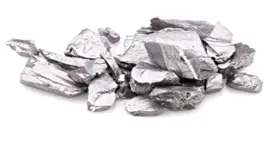
About Tantalum:
- Chemical Symbol and Atomic Number: Tantalum is a rare metal with the chemical symbol Ta and atomic number 73.
- Occurrence:
- Raw tantalum rarely occurs naturally.
- It is typically found in the ore columbite-tantalite (commonly known as coltan).
- Major Producers:
- Democratic Republic of the Congo
- Rwanda
- Brazil
- Nigeria
- Properties:
- Transition Metal: Tantalum is classified as a transition metal and is a solid at room temperature.
- Appearance: It is a shiny, silvery metal that is soft in its pure form.
- Chemical Resistance: Tantalum is almost immune to chemical attacks at temperatures below 150°C.
- Corrosion Resistance: The metal is virtually resistant to corrosion due to an oxide film that forms on its surface.
- Ductility: In its pure form, tantalum is ductile, meaning it can be stretched, pulled, or drawn into thin wires or threads without breaking.
- Refractory Metal: Tantalum belongs to the class of refractory metals, characterised by strong resistance to heat and wear.
- Melting Point: It has an extremely high melting point, exceeded only by tungsten and rhenium.
- Applications:
- Electronics:
- Tantalum is prominently used in the electronics sector.
- Tantalum capacitors can store more electricity in smaller sizes with minimal leakage, making them ideal for portable electronic devices such as smartphones, laptops, and digital cameras.
- Substitute for Platinum: Due to its high melting point, tantalum is often used as a substitute for platinum, which is more expensive.
- Industrial Use:
- Tantalum is used to manufacture components for chemical plants, nuclear power plants, aeroplanes, and missiles.
- Medical Use:
- It does not react with bodily fluids, making it suitable for surgical equipment and implants, such as artificial joints.
- Cutting Tools:
- A composite of Tantalum Carbide (TaC) and graphite is one of the hardest known materials, used on the cutting edges of high-speed machine tools.
- Electronics:
Source: PIB
Indian industry needs to move up the value chain
Context:
- India is aiming to enhance its role in Global Value Chains (GVCs) by moving up the value chain.
- This shift requires mission-led research, academic collaboration, and strong government support to transform its industries and improve their global competitiveness.
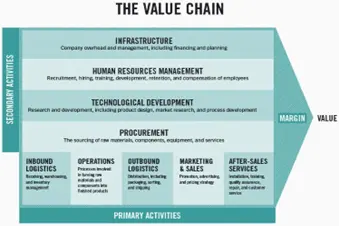
About Global Value Chains (GVCs)
About:
- Global Value Chains refer to the complex networks of production involving various countries.
- Different stages of manufacturing and distribution occur across these nations, involving suppliers, manufacturers, and distributors.
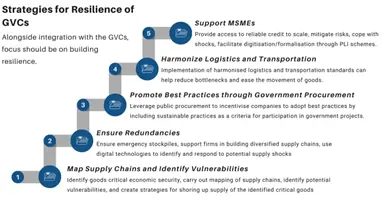
Key Determinants: Firm-Related Factors
- High Labour Productivity:
- Description: Efficient production processes and skilled workers enhance a firm’s competitiveness.
- Impact: Firms with high labour productivity are more likely to participate effectively in GVCs.
- Large Firm Size:
- Description: Bigger firms possess the resources and capacity for complex GVC activities.
- Impact: Larger firms have better negotiation power and access to global markets.
- Foreign Ownership:
- Description: Firms with foreign ownership or multinational affiliations are better integrated into GVCs.
- Impact: Cross-border ownership facilitates access to international networks.
- Technological Capability:
- Description: Essential for small and medium-sized enterprises (SMEs) to participate in GVCs.
- Impact: Advanced technologies enable SMEs to expand their engagement in GVCs.
Country-Related Factors:
- Openness to Trade and Foreign Direct Investment (FDI):
- Description: Engaging in trade and attracting FDI creates a favourable environment for GVC participation.
- Impact: Encourages firms to connect with international suppliers and buyers.
- Educated Workforce:
- Description: Availability of skilled and educated individuals enhances a country’s attractiveness for GVCs.
- Impact: A well-trained workforce handles complex tasks within the value chain effectively.
- Infrastructure:
- Description: Efficient logistics, reliable transportation, and modern infrastructure are crucial.
- Impact: Facilitates seamless movement of goods and services across borders.
- Good Governance:
- Description: Transparent and effective governance ensures a stable business environment.
- Impact: Encourages investment and builds confidence among firms in GVCs.
India’s Assets in the GVC:
- Domestic Demand:
- Description: India’s large consumer base offers significant market potential.
- Impact: Drives GVC participation and attracts global companies.
- Government Support:
- Description: Initiatives like “Make in India” promote manufacturing and innovation.
- Impact: Eases business regulations and encourages investment.
- Demographic Advantage:
- Description: A youthful population contributes to a skilled labour force.
- Impact: Makes India an attractive destination for manufacturing and services.
Challenges and Opportunities:
- GERD Gap:
- Description: India’s Gross Domestic Expenditure on Research and Experimental Development (GERD) stands at 0.6%, with industry contributing 0.2%.
- Comparison: Advanced economies invest significantly more in R&D (e.g., USA: 2.7%, South Korea: 3.9%).
- Infrastructure:
- Description: Further improvements are needed in logistics, transportation, and power supply.
- Impact: Essential for seamless integration into GVCs.
- Customs and Trade Procedures:
- Description: Simplifying customs processes can enhance competitiveness.
- Impact: Streamlined procedures facilitate smoother cross-border transactions.
- Micro, Small, and Medium Enterprises (MSMEs):
- Description: Engaging MSMEs with global lead firms is crucial.
- Impact: MSMEs play a vital role in supplying components and services within GVCs.
Key Suggestions
- Benchmarking R&D:
- Description: Increase R&D investment to compete globally.
- Action: Benchmark against global peers, set targets for R&D-led product innovation, and focus on mission-driven R&D.
- Indigenization and Exports:
- Description: Reduce reliance on high-complexity imports and boost exports.
- Action: Develop domestic capabilities to manufacture advanced products and create value-added products for global competition.
- Industry-Academia Collaboration:
- Description: Foster research labs within corporations to work with academic institutions.
- Action: Align research with revenue growth objectives and learn from successful models.
- Role of Technology:
- Digitalisation: Embrace digital technologies for efficient cross-border coordination.
- Industry 4.0: Utilise automation, IoT, and AI to boost productivity and competitiveness.
- Trade Agreements:
- Description: Pursue new Free Trade Agreements (FTAs) to expand market access.
- Impact: Reduce trade barriers and facilitate smoother movement of goods and services.
Conclusion:
India is at a pivotal moment to leverage its assets and address challenges to enhance its role in GVCs. Investing in R&D, fostering industry-academia collaborations, focusing on indigenization, and embracing technological advancements are crucial steps. By addressing these areas, India can move up the value chain, reduce imports, and boost exports, contributing to its economic growth and global competitiveness.
Share the article
Edukemy’s Current Affairs Quiz is published with multiple choice questions for UPSC exams
MCQ
Get Latest Updates on Offers, Event dates, and free Mentorship sessions.

Get in touch with our Expert Academic Counsellors 👋
FAQs
UPSC Daily Current Affairs focuses on learning current events on a daily basis. An aspirant needs to study regular and updated information about current events, news, and relevant topics that are important for UPSC aspirants. It covers national and international affairs, government policies, socio-economic issues, science and technology advancements, and more.
UPSC Daily Current Affairs provides aspirants with a concise and comprehensive overview of the latest happenings and developments across various fields. It helps aspirants stay updated with current affairs and provides them with valuable insights and analysis, which are essential for answering questions in the UPSC examinations. It enhances their knowledge, analytical skills, and ability to connect current affairs with the UPSC syllabus.
UPSC Daily Current Affairs covers a wide range of topics, including politics, economics, science and technology, environment, social issues, governance, international relations, and more. It offers news summaries, in-depth analyses, editorials, opinion pieces, and relevant study materials. It also provides practice questions and quizzes to help aspirants test their understanding of current affairs.
Edukemy's UPSC Daily Current Affairs can be accessed through:
- UPSC Daily Current Affairs can be accessed through Current Affairs tab at the top of the Main Page of Edukemy.
- Edukemy Mobile app: The Daily Current Affairs can also be access through Edukemy Mobile App.
- Social media: Follow Edukemy’s official social media accounts or pages that provide UPSC Daily Current Affairs updates, including Facebook, Twitter, or Telegram channels.

